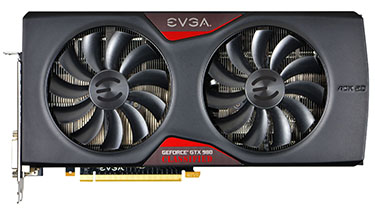Introduction
EVGA tends to release a number of graphics cards based on Nvidia's leading-edge GPUs. The reference card is presented in standard and Superclocked forms. These are joined by EVGA-designed models using in-house-developed cooling allied to higher core frequencies. A little while later, generally when sufficient time has passed to enable effective GPU screening, the humongous Classified model makes a bow. That time is now.
The Classified ACX 2.0 uses an extra-large PCB and cooling that's a scaled-up version of the standard-sized Superclocked ACX 2.0. Measuring 279mm and standing at an improbable 151mm high - therefore significantly taller than the I/O bracket - the extra space provides ample room for more efficient cooling and improved power delivery. Two large fans deliver significant airflow at reasonable RPMs. And like most GeForce GTX 970 and GTX 980 GPUs the BIOS is programmed such that the fans remained switched off at below 60-65°C.
Known as a model taken on by hardcore enthusiasts in search of record-setting numbers, Classified uses a total of 14 power phases to provide smooth power to the core and memory, up from a total of five power phases for the generic reference card. This is a card rife for overclocking, clearly, and EVGA sets out-of-the-box frequencies at 1,291MHz core (1,393MHz boost) yet the 4GB framebuffer is kept at the default 7,012MHz. Pipped to the frequency post by the recently reviewed Galax HOF, EVGA's card still manages a very respectable average in-game speed of 1,430MHz across our titles.
Providing the power oomph is two eight-pin PCIe connectors sensibly located down one edge. EVGA purposely goes wider and longer than taller, because the Classified remains a two-slot card. As such, adding a second or third in a large chassis shouldn't pose any major problems. There's also a splattering of white LEDs sandwiched between the cooler and PCB, if you're into that sort of thing.
Certain features are only present on these Classified boards, and a peek down the left-hand edge is instructive. The GTX 980 version has the usual EVBot interface that enables overvolting past Nvidia's recommended specifications, which is particularly useful if you're planning on watercooling the card for maximum performance. A small switch toggles one of three BIOSes, handy if experimenting with unofficial ROMs that provide greater scope for frequency adjustment - more on this later. And speaking of BIOSes, the card is fully compliant with the UEFI standard that provides super-quick boots to the desktop.
Readers may understandably baulk at the £570 retail price for this enthusiast-grade card. Shipping frequencies are barely any higher than the £450 Superclocked ACX 2.0, which will perform very closely in regular benchmarks, but that's missing the point somewhat. This card, pregnant with potential promise, is designed to be pushed and prodded to sky-high frequencies, so it's not a product primed to run at out-of-the-box frequencies.
EVGA sweetens the overall deal by offering European customers a free Torq X10 gaming mouse as part of a card purchase for a limited time when purchasing through the official EVGA EU online store; the carbon version mouse is available for an extra €26. Meanwhile, the usual three-year transferable warranty is upgraded to five years for all European buyers, again for a limited time, with the opportunity to further increase the term via extended warranty options.
A fully-custom PCB heralds a custom I/O section. EVGA reduces the outputs to four, which can all be used concurrently, and drops two of the reference card's DisplayPort v1.2 in favour of adding a DVI-D.
Excellent build quality and above-average cooling bodes well for the EVGA Classified ACX 2.0. Let's now fire up the benchmarking machine and put it through the usual paces.














